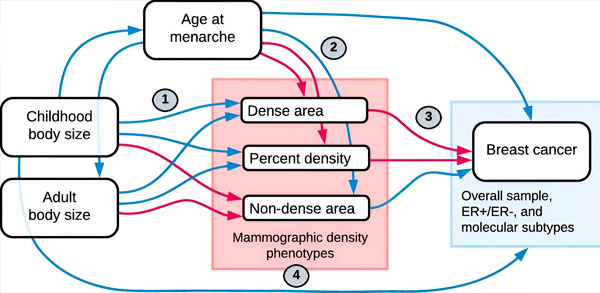
乳腺癌是全球女性中最常见的癌症。随着乳腺癌发病率的不断上升,迫切需要发现新的可改变的乳腺癌风险因素。布里斯托大学的一项新研究表明,儿童肥胖会导致乳腺组织密度降低,从而降低患乳腺癌的风险。然而,仍需进一步研究,以了解儿童肥胖的整体保护作用机制,并确定新的干预和预防目标。
《自然通讯》杂志发表的一项研究调查了儿童时期体型较大对乳腺癌风险的不明保护作用,采用孟德尔随机化方法检查了儿童时期和成年时期体型、青春期时间、乳腺组织密度和乳腺癌风险之间的关系。
研究小组详细研究了最有可能的联系之一:乳腺组织密度。通过乳房X光片测量的乳腺密度高是乳腺癌的已知风险因素,并且已知其会随着体型而变化。
如果乳房X光片显示乳腺组织致密,则意味着乳腺中的腺体或纤维组织比脂肪组织多。反之,如果乳腺组织致密,则意味着脂肪组织比腺体或纤维组织多。
越来越多的证据表明,儿童时期的脂肪组织可能导致成年后的各种疾病。然而,就乳腺癌风险而言,观察性流行病学研究以及近期利用基因数据的研究都表明,儿童时期体型较大可降低罹患乳腺癌的风险。
研究人员使用了全基因组关联研究 (GWAS) 和孟德尔随机化分析的数据。他们证明,儿童时期较大体型对乳腺癌风险的保护作用,超过 50% 可由致密乳腺组织的变化来解释。
研究小组认为,儿童时期(青春期开始时)体型较大会导致乳房组织密度降低。致密区域是乳房中通常容易发生癌症的部分(腺体和纤维组织)。
乳腺中致密区域较小,成年后患乳腺癌的风险较低。这被认为是儿童时期体型较大可降低乳腺癌风险的机制。然而,其生物学机制/途径更为复杂,利用基因数据识别这一过程中的细微步骤,有助于揭示这种无法解释的因果关系的根源。

本研究中调查的性状之间关系的流程图。来源:《自然通讯》(2024)。DOI:10.1038/s41467-024-48105-7
英国医学研究理事会综合流行病学部 (MRC IEU) 和布里斯托尔医学院人口健康科学系 (PHS) 的 Marina Vabistsevits 博士及通讯作者表示:“探索儿童肥胖的保护作用机制非常重要,因为儿童时期体重增加不能被视为预防乳腺癌的措施。
“研究这种普遍的‘保护’如何发挥作用对于理解导致癌症发展和预防的潜在机制至关重要,因为它可能有助于确定干预和预防的新目标。”
该研究通过与西奈山伊坎医学院和美国北加州凯撒医疗集团的合作得以实现,他们为该项目分享了宝贵的乳房 X 线密度数据。

